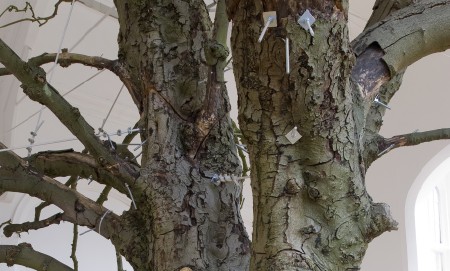Anya Gallaccio
Anya Gallaccio’s new installation at Camden Arts Centre, London, addresses environmentalism and our complex relationship with the natural world
Anya Gallaccio’s new installation at Camden Arts Centre, London, addresses environmentalism and our complex relationship with the natural world
For that open space within (2008), Gallaccio has filled the smaller gallery at Camden with a section of a horse chestnut tree, recently removed from a London park after it died. The tree is huge, filling the high-ceilinged space, its branches pushing against the windows and walls as though they were about to burst out of the building at any moment. In spite of its mighty presence, however, the tree is obviously lifeless: its limbs are hacked and re-pinned, held in place by crisscrossing struts and ropes. These accoutrements give an impression of Frankenstein’s monster, brutally rebuilt and harnessed, despite the fact that all its sections have sprung from the same organic form. This method of reconstruction has created a curious mixture of both the real tree and a representation of it.

This is not the first time that Gallaccio has brought trees into a gallery space: in 2002 she filled Tate Britain’s Duveen Galleries with tree trunks that stood mutely in the long space, stunted by the amputation of all their limbs. In the sculptural work Because Nothing Has Changed (2000), Gallaccio adorned a bronze tree with bright red porcelain apples, and later created a revised version incorporating the best-known aspect of her work, Because I Could Not Stop (2002), which was strewn with real apples that rotted over the course of the show.
Her installation at Camden depends similarly on both a quiet event – the reconstructed tree will be dismantled at the end of the exhibition – and a traditionally sculptural form. There are countless depictions of nature and trees in art, yet here is the real thing. The tree’s bearing brings forth memories of country walks or childhood games of conkers, but it remains still and cruelly tethered, ready to be scrutinised.
Gallaccio apparently drew inspiration for the work from Camden Arts Centre's garden and from the notion of bringing the outdoors inside. However, what is more striking is not the garden but the relentless presence of the Finchley Road outside the window. The effect of the passing traffic is disorientating, with the inside space appearing more natural than the mechanical world outside. Whether deliberately intended by the artist or not, it feels difficult not to see the work in political terms, as a commentary on the increasingly bleak proclamations that are emerging about our environmental future.























